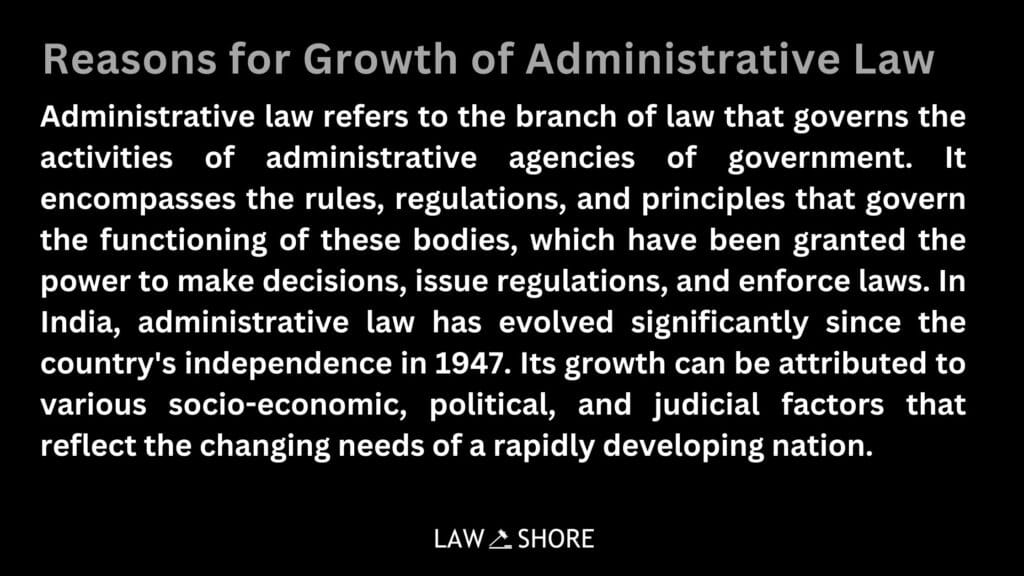Reasons for Growth of Administrative Law
Table of Contents
ToggleAdministrative law refers to the branch of law that governs the activities of administrative agencies of government. It encompasses the rules, regulations, and principles that govern the functioning of these bodies, which have been granted the power to make decisions, issue regulations, and enforce laws. This article seeks to explore the reasons for growth of administrative law in India, examining the historical, constitutional, political, and social contexts that have influenced its development.
In India, administrative law has evolved significantly since the country’s independence in 1947. Its growth can be attributed to various socio-economic, political, and judicial factors that reflect the changing needs of a rapidly developing nation.

Historical Context: From Colonialism to Independence
Before independence, administrative law in India was largely shaped by British colonial rule. The colonial administration introduced a legal framework that emphasized executive control over governance, with little to no scope for judicial intervention or public participation. The Indian government during the colonial period was heavily centralized, and administrative law was concerned mainly with enforcing executive orders and maintaining law and order.
However, after independence, the Indian government sought to establish a system of governance that was more inclusive, transparent, and accountable. This shift necessitated the development of administrative law as a distinct and growing body of legal principles.
Constitutional Framework and Judicial Interpretations
The Constitution of India, adopted in 1950, provided a solid framework for the development of administrative law. Several provisions of the Constitution indirectly facilitated the growth of administrative law in India. Key elements include:
Separation of Powers:
The Constitution establishes a system of governance based on the separation of powers among the legislature, executive, and judiciary. While the legislature creates laws, the executive (through administrative agencies) is tasked with their implementation. The judiciary, in turn, acts as a check on the abuse of executive power, ensuring that administrative decisions comply with the rule of law. This separation of powers principle has necessitated the development of administrative law to govern executive actions and ensure they conform to constitutional and statutory limits.
Article 14 (Right to Equality):
Administrative law has grown in response to the constitutional mandate under Article 14, which guarantees the right to equality before the law. This provision ensures that administrative authorities must act fairly, justly, and without bias. Administrative law provides the framework within which fairness, transparency, and accountability are ensured in the exercise of executive power.
Article 21 (Right to Life and Personal Liberty):
The expansive interpretation of Article 21 by the judiciary has had a significant impact on administrative law in India. The courts have recognized that arbitrary or unreasonable administrative actions, which violate personal liberty or are unjust, can be challenged under Article 21. This judicial interpretation has contributed to the growth of administrative law, especially in areas like public health, welfare, and individual rights.
Judicial Review:
One of the primary reasons for the growth of administrative law in India has been the expanding role of the judiciary in reviewing administrative actions. The Indian judiciary has established that administrative decisions must be subject to judicial scrutiny to ensure they are not ultra vires, arbitrary, or unreasonable. Over the years, the judiciary has expanded the scope of judicial review, significantly enhancing the development of administrative law.
Political and Social Factors
Expansion of State Functions:
After independence, India embarked on an ambitious path of state-led development, aiming to address social inequality, poverty, and underdevelopment. This necessitated the creation of numerous government agencies to implement welfare schemes, regulate industries, and provide public services. As the role of the state grew, so did the need for a legal framework to regulate administrative powers. The rise of public administration and regulation in sectors like health, education, housing, and labor further strengthened the need for administrative law.
Bureaucratic Expansion:
With the expansion of government functions, there was a corresponding growth in the number of administrative agencies, bureaucrats, and regulatory bodies. These agencies began to exercise considerable power in shaping public policy, enforcing regulations, and making decisions affecting citizens’ rights. This growing power of administrative bodies, often without sufficient checks, prompted the development of administrative law to ensure accountability, transparency, and fairness.
Socio-Economic Changes:
India’s socio-economic development, particularly after economic liberalization in the 1990s, led to increased regulation in sectors such as telecommunications, banking, finance, and public utilities. The expansion of private sector involvement and the growing complexity of economic activities called for more sophisticated administrative structures, regulations, and legal frameworks. This created a need for comprehensive administrative laws to regulate the functioning of these agencies.
Judicial Evolution and Development of Administrative Law
Indian courts have played a significant role in shaping administrative law. The judiciary’s interpretation of laws and its decisions in landmark cases have influenced the scope and growth of administrative law in the country.
Expansion of Judicial Review:
Initially, judicial review of administrative decisions was limited. However, over the years, the Indian judiciary has adopted a more expansive interpretation of judicial review under Articles 32 and 226 of the Constitution. Landmark decisions like Maneka Gandhi v. Union of India (1978), R. v. Union of India (1979), and L. Chandra Kumar v. Union of India (1997) have reinforced the role of the judiciary in ensuring that administrative actions do not violate fundamental rights or the rule of law. These decisions have enhanced the protection of citizens’ rights against arbitrary executive actions.
Development of Natural Justice Principles:
Administrative law in India has also been shaped by the growing recognition of the principles of natural justice. The courts have consistently emphasized that administrative authorities must follow fair procedures and provide adequate opportunities for affected parties to be heard before making decisions. This has led to the codification of principles of fairness, reasonableness, and transparency in administrative decision-making.
Public Interest Litigation (PIL):
The rise of Public Interest Litigation in India has provided a new avenue for citizens and non-governmental organizations to challenge administrative actions. Through PIL, courts have addressed issues such as environmental protection, human rights, and the rights of marginalized communities. This expanded role of the judiciary has strengthened the framework of administrative law, as courts are increasingly involved in scrutinizing the legality and fairness of administrative decisions.
Regulatory and Statutory Frameworks
Enactment of Statutes:
The Indian government has enacted numerous statutes that regulate administrative functions in various sectors, contributing to the development of administrative law. Examples include the Right to Information Act, 2005, the Public Procurement Bill, the Environmental Protection Act, 1986, and the Consumer Protection Act, 2019. These laws have established specific regulatory frameworks that govern the functioning of administrative agencies and provide mechanisms for accountability and transparency.
Tribunals and Regulatory Bodies:
Administrative tribunals, such as the Central Administrative Tribunal (CAT) and various state tribunals, have emerged as specialized forums for resolving disputes involving administrative agencies. These tribunals have played an important role in decongesting regular courts and providing a more efficient mechanism for addressing administrative issues.
Conclusion
The growth of administrative law in India is the result of a combination of historical, constitutional, political, social, and judicial factors. The expansion of government functions, the rise of bureaucratic power, the need for accountability, and the increasing complexity of governance have all contributed to the evolution of administrative law.
The judiciary, in particular, has played a pivotal role in shaping administrative law, ensuring that executive actions remain within the framework of the Constitution, respect citizens’ rights, and adhere to the principles of fairness and justice. As India continues to develop and modernize, the role of administrative law will only increase in importance, providing the legal tools necessary to navigate the complexities of a diverse and dynamic society.
Also, Check Out Other Topics in Administrative Law:
- Introduction and Scope of Administrative Law
- Droit Administratif
- Ombudsman in Administrative Law
- Promissory Estoppel in Administrative Law
- Public Corporation in Administrative Law
- Separation of Powers in Administrative Law
- Doctrine of Ultra Vires in Administrative Law
- Whistleblowing
- Nature of Administrative Law
- Red Light and Green Light Theory of Administrative Law
- Sub Delegation in Administrative Law
- Delegatus Non Potest Delegare
Explore Law Shore: law notes today and take the first step toward mastering the fundamentals of law with ease.

After Completing my LLB hons, I started writing content about legal concepts and case laws while practicing. I finally started Law Shore in 2024 with an aim to help other students and lawyers.



